| Srl | Item |
| 1 |
ID:
105071
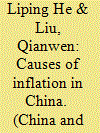

|
|
|
|
|
| Publication |
2011.
|
| Summary/Abstract |
This paper argues that the main causes of inflation in China since the early 21st century are changes in the public's inflation expectations. The conventional wisdom, the quantity theory of money, may not be adequate to capture the relationship between price changes and money supply growth, as the economic system evolves and people's income and wealth grow. An examination of China's GDP deflator and broad money supply relative to nominal GDP shows that the relationship between the two series is relatively weak. A further examination of China's monthly CPI series over the period 2001-2010 reveals that the autoregressive models are a better fit than the moving average models, which suggests that the role of CPI expectations has been significant and important. Because of the importance of inflation expectations in CPI movement, we believe the Central Bank's monetary policy that targets CPI inflation should emphasize the use of policy instruments that have direct and strong communication links with the public. Quantitative measures would have their own use, but their effectiveness would be unlikely to match that of interest rate measures, especially from a short-term perspective.
|
|
|
|
|
|
|
|
|
|
|
|
|
|
|
|
| 2 |
ID:
105076
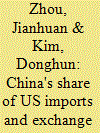

|
|
|
|
|
| Publication |
2011.
|
| Summary/Abstract |
The present paper investigates the effect of China's share of US imports on the aggregate-level exchange rate pass-through to US import prices over the period from January 1999 to December 2008. The paper also focuses on the post-reform period, after 2005, allowing greater flexibility of the RMB to explore the change in the role of the Chinese import share in determining the trend in the US exchange rate pass-through. Evidence reveals that China's share of US imports has a negative effect on the exchange rate pass-through. However, this negative effect has been moderated to a negligible level since China's exchange rate reform. An important implication is that the exchange rate flexibility of the RMB has been raised to a significant level may no longer cause distortion in the US competitive environment and prevent the USA from adjusting current accounts.
|
|
|
|
|
|
|
|
|
|
|
|
|
|
|
|
| 3 |
ID:
105073
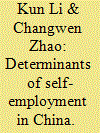

|
|
|
|
|
| Publication |
2011.
|
| Summary/Abstract |
This paper presents and tests a series of sources of regional variations in self-employment rate in China in the 2000s, and illustrates that the stage of economic development is a major explanation for the variations of self-employment rate across regions over the past decade. The negative relationship between the stage of economic development and self-employment rate identified in the paper indicates that China has entered the process of fast industrialization, and self-employment is playing a diminishing role in economic growth and employment. We also find a substitution effect between self-employment and private enterprises. While both are important components of China's private sector, private enterprises are becoming an increasingly important source of China's economic growth and employment. Furthermore, our findings also imply that when job opportunities are limited, self-employment in China is likely a forced choice of disadvantaged people who are not qualified for wage jobs.
|
|
|
|
|
|
|
|
|
|
|
|
|
|
|
|
| 4 |
ID:
105074
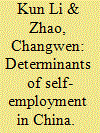

|
|
|
|
|
| Publication |
2011.
|
| Summary/Abstract |
This paper presents and tests a series of sources of regional variations in self-employment rate in China in the 2000s, and illustrates that the stage of economic development is a major explanation for the variations of self-employment rate across regions over the past decade. The negative relationship between the stage of economic development and self-employment rate identified in the paper indicates that China has entered the process of fast industrialization, and self-employment is playing a diminishing role in economic growth and employment. We also find a substitution effect between self-employment and private enterprises. While both are important components of China's private sector, private enterprises are becoming an increasingly important source of China's economic growth and employment. Furthermore, our findings also imply that when job opportunities are limited, self-employment in China is likely a forced choice of disadvantaged people who are not qualified for wage jobs.
|
|
|
|
|
|
|
|
|
|
|
|
|
|
|
|
| 5 |
ID:
054847


|
|
|
|
|
| Publication |
Mar-Apr 2003.
|
|
|
|
|
|
|
|
|
|
|
|
|
|
|
|
| 6 |
ID:
105072
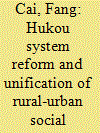

|
|
|
|
|
| Publication |
2011.
|
| Summary/Abstract |
Using a political economy analytical framework, the present paper examines the hukou system reform in China. The potential unification of the social welfare system of rural and urban areas is discussed. The paper reviews the progress of hukou system reform since 2004. It is suggested that since China met its Lewis turning point in about 2004, and a labor shortage became a limiting factor in production, there has been stronger demand for hukou system reform. In the meantime, various levels of government have a point where incentives are compatibile for carrying out reforms. The paper also explores some limitations of the currently implemented reform in certain regions and puts forward relevant policy suggestions.
|
|
|
|
|
|
|
|
|
|
|
|
|
|
|
|
| 7 |
ID:
105075


|
|
|
|
|
| Publication |
2011.
|
| Summary/Abstract |
This paper investigates the relationship between labor quality and inward foreign direct investment (FDI) distribution in China using a large sample of Chinese cross-sectional, firm-level data, with comprehensive information about labor quality. The paper finds that labor quality measured by education level plays an important role in deciding the distribution of inward FDI, but labor quality measured by working certificates loses its significance using non-parametric matching techniques and the instrumental variables and generalized method of moments technique. The author also finds that labor quality has a more significant impact on other foreign investments than Hong Kong-invested, Macau-invested and Taiwan-invested firms. The impacts of labor quality on inward FDI are found to be strongly uneven across industries and provinces. Therefore, China should pay more attention to the education of employees in all foreign-invested firms, and invest more in education to improve labor quality, which will help China to attract more FDI, especially technology-intensive FDI.
|
|
|
|
|
|
|
|
|
|
|
|
|
|
|
|
| 8 |
ID:
105070


|
|
|
|
|
| Publication |
2011.
|
| Summary/Abstract |
This paper proposes that inflation in China during the post-reform era (1978 onwards) is always a monetary phenomenon. We construct a multivariate dynamic model based on Friedman's quantity theory of money and use the standard Granger causality test to show that money growth contains significant predictive power for inflation during the underlying period. The finding is robust to alternative measures of monetary aggregates and both closed and open economy frameworks. The baseline finding of the paper indicates that quantitative tools remain the most important policy instruments for China to manage its inflation effectively.
|
|
|
|
|
|
|
|
|
|
|
|
|
|
|
|